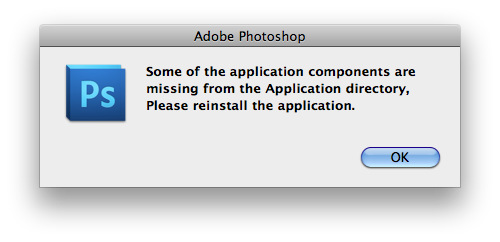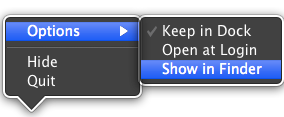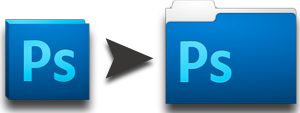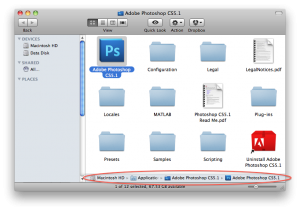Some of the application components are missing from photoshop что делать
“application components are missing” in Photoshop
Home / General Software / Adobe Creative Suite / “application components are missing” in Photoshop
Problem
Adobe Photoshop shows the following error when you try to launch the application:
“Some of the application components are missing from the Application directory, Please reinstall the application”.
Error shown when attempting to launch Photoshop.
Cause
The application has been moved from its correct location.
Solution
How to find an applications location by using Ctrl+Click on a Dock item.
Drag Photoshop icon to Photoshop folder
Example of a correct location for Adobe Photoshop CS5.1
12 Responses to “application components are missing” in Photoshop
At step #2, still get the prompt “Some of the application components are missing from the Application directory …” upon launch attempt.
I’ve added a screenshot to show an example of the correct file location. When you ctrl + click (or right click) on the photoshop icon in the dock and select ‘show in finder’ what is the path it shows for you?
Thanks a lot, it solved my problem
Thank you SO much I was in a panic. thank you thank you thank you
I transferred Photoshop via usb and dont have a parent folder. What do I do?
Unfortunately you can’t transfer Photoshop this way and need to do a fresh install on your current mac.
Having this same problem but when you say “Drag it back to the correct parent folder, this will allow you to launch the app.” How do I do this…where is the parent folder all i get is the application when show in finder but don;t know where to drag it to
I think I follow. I’ll try and clean up the instructions a little later. This error is caused when the application is moved away from the installed directory for photoshop/illustrator/indesign.
Select the application file and press ‘cmd + i’. In the general tab it should tell you ‘where’ the file is located, e.g. ‘/Applications/Adobe Photoshop CS5.1’.
If it isn’t a folder similar to above then open up a new finder window, press ‘shift + cmd + a’ to go to the applications folder. Inside that should be the correct adobe folder, then drag your application into that folder.
Hopefully this helps, if it doesn’t let me know which program and version you are using and I’ll let you know the exact path.
there isn’t folder named “Adobe Photoshop CS5.1′”
the app is under the application folder directly
Just a couple of questions first and we’ll see how we can help.
1) When you right click and show in folder, what is the folder path? ie ‘/application/adobe photoshop cc’.
2) If you app file is in that folder (or similar depending on your version) do you have a locales folder in that folder?
3) And finally what method did you use to install photoshop on you mac?
Tried fixing this via Apple’s official solutions and came up with, no surprise, crap.
You nailed it quickly – precisely – and simply.
Some of the application components are missing from photoshop что делать
Привет
Научите или помогите нарисовать аккуратную плавную линию.
Задумка такая: буква «Д»должна стать частью контура поясной сумки. Пример на картинке.
Нужна одна плавная линия, примерно повторяющая контур сумки. Толщина этой линии должна соответствовать толщине остальных линий.
У меня никак не получается нарисовать аккуратно.
Помогите, пожалуйста. Умоляю.
Не читай это, если не хочешь зарабатывать от 1000$ на ретуши
Хочу поделиться с тобой опытом, знаниями как делать сочную ретушь, зарабатывать на любимом деле не выходя из дома
Это шанс пройти обучение у гуру фэшн ретуши (я работаю с VOGUE, Vanity Fair и др.) да еще и с гарантией трудоустройства. Круто? По-моему, да. Если бы у меня был такой шанс, когда я начинала, я бы не задумываясь его хватала.
Что скажешь? Хочешь ко мне в команду? Пиши в лс Nadezhda Vasilenko
Basic troubleshooting steps to fix most issues
Important:
Photoshop’s 3D features will be removed in future updates. Users working with 3D are encouraged to explore Adobe’s new Substance 3D collection, which represents the next generation of 3D tools from Adobe.
Additional details on the discontinuation of Photoshop’s 3D features can be found here: Photoshop 3D | Common questions around discontinued 3D features.
This document contains basic troubleshooting steps that should solve most problems you can encounter while using Photoshop. Try all the steps below before posting on the forum for Photoshop-specific issues.
Known issues in Photoshop
Check to see if the issue you’re encountering is a known issue in the latest release of Photoshop.
Get the latest Camera Raw support
The most commonly asked support question is «Photoshop doesn’t recognize my new camera’s raw files. How to I get Photoshop to open my raw files?»
Install application updates
You can fix many problems by simply making sure that your Adobe software is up-to-date.
Install operating system updates
You can fix many problems by simply making sure your operating system is up-to-date.
Adobe recommends that you perform your own testing on a non-production partition to ensure that brand-new operating systems work well with your current hardware and drivers.
Creative Cloud doesn’t show available updates, or applications are in trial mode
Not seeing the available updates? Are your applications showing as trials?
I can’t activate Photoshop, or applications are in trial mode
Not able to activate Photoshop, or applications are appearing as trials?
Install graphics card (GPU) driver updates
If you’re experiencing image rendering issues, slow performance, or crashes, the cause could be a defective, unsupported, or incompatible graphics driver.
Troubleshoot graphics processor
In some cases, having the latest driver may not cure all problems related to video adapters and drivers.
The quickest and easiest way to determine if the problem is with your video adapter or driver is to disable the Use Graphics Processor preference.
For specific errors, see the following:
Restore preferences
Reverting Photoshop’s preferences to their factory-fresh state can solve many issues (including program errors, strange tool/interface behavior, etc).
Troubleshoot plug-ins
Many issues can arise from using incompatible, outdated, or incorrectly installed plug-ins.
Troubleshoot fonts
Many problems can occur when you use third-party fonts, including crashing or hangs when selecting the Type tool or when making the Character panel active/visible. A bad font or fonts can also cause general performance issues when launching or using Photoshop. Validate and remove duplicate or troublesome fonts to improve stability and text tool performance.
Photoshop is crashing
If you perform all the steps above and you still encounter a crash, be sure to submit all crash reports. If you submit a crash report for a known issue to Adobe with your email address, we can email you a solution for correcting the problem.
Photoshop is slow or lags
Unexpected results using a tool
If a tool in Photoshop isn’t working properly (for example, the crop tool crops a tiny little gray square, or painting with a brush paints the wrong color or nothing at all), try resetting the tool settings:
Troubleshoot cursor display or size issues
Missing tools
If a tool or multiple tools are missing from the Toolbar, try resetting Toolbar customization to the default. To do this, select Edit > Toolbar and click Restore Defaults in the right-hand column.
If you’ve selected a workspace other than Essentials, each of the other workspaces in Photoshop customize the Toolbar to present a different set of tools. Selecting Window > Workspace > Essentials (Default) or Window > Workspace > Reset Essentials can also restore the default Toolbar.
You can also use the Discover panel within Photoshop to search and identify tools. Use the keyboard shortcut Command/Control + F to get the search dialog box, type the name of the tool you’re looking for and select the desired result. Photoshop will highlight and activate the tool in the UI.
Troubleshoot user permissions
If none of the troubleshooting steps above solve your problem, your problem may be related to user permissions.
Admin user account
Create an admin user account to identify permissions problems. For instructions on creating an admin user account, see the following:
Be sure to change the New Account pop-up window from Standard to Administrator when creating the user.
Windows:
After you create the admin user account, log in to the new user and run Photoshop to see if the problem goes away.
Non-admin user account
When running Photoshop from a non-Administrator account, Photoshop requires read access to some system-level folders and read/write access to some user-level folders.
Note: A user account with full administrative rights is required for installation.
Read/write access is required to the root folder of any non-boot drive that is specified in Photoshop’s Preferences as a scratch disk.
Read/write access is required to any folders into which you’ve saved files.
Read/write access is required to these user-level folders:
Read access is required to these system-level folders:
Note: The System Library folder is different from the Users’ Library folder.
1. Choose Go > Computer
2. Select Macintosh HD > System > Library.
How to Fix JavaFX’s “Runtime Components are Missing” Error
If you’re not familiar with Java modules, you’re almost guaranteed to get hit with an error: “Runtime Components Are Missing”. It can be a huge frustration if you’re trying to get into JavaFX. Even if you consider yourself to be pretty Java-savvy.
One side effect of Oracle removing JavaFX from the JDK was to make it harder to get started. Honestly, JavaFX should be a very intuitive and easy to use piece of software. But this is one of the few awkward stumbling blocks that trips a lot of people up.
A “Runtime Components are Missing” error is generated by the Java Launcher. It is generated for all non-modular JavaFX projects since Java SE 9. However, it can be corrected by adding JavaFX modules, using command line arguments.
When I first came back to JavaFX after using it in Java 8, every single one of my old prototypes crashed. So if you’ve had this error don’t be disheartened. It’s a relatively easy fix.
How we’re going to fix it
The good news is there are several easy ways to fix your app. Generally, there are two situations you could be in to find this error.
The solutions in each case can be similar, although if you can’t make your app modular you will have to apply command-line arguments both in the IDE and with your Jar.
I’ll start with launching from the IDE, because that seems natural. If you’ve got a Jar that won’t run, feel free to skip on down.
I’ll talk a little about why this is happening, because it has to do with JavaFX’s custom windowing and rendering systems. But, I completely understand if you just need those fixes, you can skip ahead to there too.
Fixing Runtime Components in the short term
This is a wildly irresponsible cowboy fix, but if you’re not looking to a long-term stable project (for example university projects or prototyping), it can be a good way to get around the issue for now.
To jury-rig the Java launch process and fool the LauncherHelper into not realising your app is an instance of a JavaFX Application, you can create a dummy class to act as an entry point to the program.
In this case, we’ll set MyLauncher as the main class for the application and the only responsibility of this class will be to launch our actual application!
The benefit of this fix is that it will get rid of this error in both the IDE and with a packaged Jar. That being said, I’d really recommend checking out some of the more sustainable fixes below.
Especially in the case of an app you want to deploy in a production environment, you’ll have a much bigger job changing your application when it’s already in production.
If you’re curious as to why JavaFX needs to check that the runtime components are present, check out the drop-down below.
Why JavaFX needs ‘Runtime Components’
Java has other windowing solutions that don’t need this custom support, so why does JavaFX? Well, the Abstract Window Toolkit (AWT) has been with Java since the beginning. In that sense, it’s baked into the Java runtime. Swing, which also provides a GUI framework, is sat on top of AWT.
Swing, JavaFX uses its own custom windowing toolkit – glass – which is used in combination with prism, its graphics engine. Both of these are inside the javafx.graphics module. When JavaFX was added, the Java launcher was modified to allow JavaFX to set itself up before the application launched.
This is done inside a class called LauncherHelper, which is called whenever any class or jar is run.
In fact, the main class that the FXLauncher launches isn’t the main class of your application. In this case, FXHelper does the any setup needed before checking back in with our app.
One fix I’ll go through today short-circuits this test by jury-rigging the launch process to fool Java into thinking it’s not a JavaFX application. For small projects, that’s OK, but if you’re looking at developing a production-level or portfolio app, there are other, more sensible ways to do this.
If you’re looking for a really fast fix, though, it does the job.
Fixing JavaFX Runtime Components Issues Responsibly
A lot of these fixes aren’t a lot harder than the cowboy fix above, but they do take a little bit of understanding, or a tiny bit of patience.
in the first case, converting to modules takes a litte bit of understanding. But it’s a fix that will work in both the IDE and the Jar. If you choose to provide VM arguments manually, you’re going to need to provide these to run the Jar too – hence the patience.
1. Make your app modular
By far and away the most future-proof way to fix this error is to convert your project over to a modular one. That being said, it’s not always practical. There are plenty of libraries that currently don’t fully support java 9 modules (Apache POI is a great example)
It can also be a little intimidating if you haven’t migrated yourself across to modular projects yet.
Why convert to Modular
From Java 9 and onwards, Java has modularized. In part, it’s to give you flexibility to add modules easily to your runtime image without including a bunch of jars. But in part it’s because Oracle can no longer assume that Java will exist on every machine you might ship your code to.
A few years ago, when Java aggressively pushed the JRE with manufacturers, it was a safe bet that a JRE existed on most machines. But, nowadays this just isn’t the case. So, developers find themselves shipping their program (which might be quite small) with a 200 MB JRE.
With Java modules, you can include just the modules you need, to make a custom JRE of a much smaller size.
The price you pay for shedding up to 150 MB off the program you’ll eventually ship is that you need to specify which modules your program requires. If there isn’t an overwhelming reason why you need to stay pre-modular, I would suggest the a few lines of code (5 in this case) is more than worth it.
There are three things you need to add some basic modules to a simple App. Obviously, the modules you need will be guided by the modules you use in your program, but the three basic rules are:
1. Getting access to other modules
If course, if you’re not using a build framework, you will still need to download the javafx.graphics and javafx.base jars or jmods for your program to work.
2. Giving reflective access to your module
The JavaFX graphics module injects fields into a Controller using reflection. This is useful, because it facilitates dependency injection, but it means we need to grant reflective access. That requires the opens keyword.
3. Giving other access to your module
Part of that process is that the FXLauncher operates on our main class in order to launch it (check out “Why JavaFX needs Runtime Components” in the dropdown above), we need to allow that too.
3. Putting it all together
That’s all we need. If you want more detail on adding modules to a project, check out my post on setting up a modular project with Maven.
Honestly, Java’s module system means that Java is now purpose-built to do things like add in JavaFX. For me this is the logical way to fix the project.
2. Add command-line arguments to your app
This is a pretty flexible fix, which can be done in any IDE. The caveat is that you’ll also need to provide the same arguments when running your Jar. For this to work, you’ll need to know the location of the JavaFX SDK you’ve downloaded on your machine.
I’ll go through what the parameters are first, then how to add them to your IDE. Finally, we’ll cover how to add these arguments when running your jar.
The module parameters you need to add
To fix this, we’re going to pass two sets of parameters to Java as we run our code.
1. Module Path
2. Modules to add
Next, we’ll add them into the IDE run configuration.
Adding VM arguments in an IDE
The most popular are Eclipse and IntelliJ, so I’ll include some screenshots here, but this should work no matter which environment you’re developing in.
a. Eclipse
b. IntelliJ
And that’s it! Your program should run in the IDE.
Adding VM arguments to a Jar
If dependencies or project-constraints are stopping you from converting your project to a modular structure and rebuilding your Jar, you can still run your jar using a batch (or shell) script providing the runtime arguments to the launcher.
If you don’t know how to create these files, here’s how. I’ll run through how to create both batch and shell scripts on Windows and Mac/Unix systems. In either case, we’ll be running the same command.
1. Creating a batch file
In Windows, create a file labelled launcher.bat in the same directory as your Jar file. Right click and select “edit” to edit your file.
Add the text, editing your module path so it points to the lib folder of the JavaFX SDK you have on your system, and save. 👍
To launch your application, simply double-click the script file, or launch it from the terminal.
2. Creating a shell file
In Linux or on Mac, launch the terminal and navigate to the folder with your jar, and create a file using the command «touch launchScript “.
Using your favourite text editor, we’ll need to add two commands to the file. The first directs the system to run launchScript as a shell script, and the second runs our app with the VM arguments.
Again, edit your module path so it points to the lib folder of the JavaFX SDK you have on your system, and save. In the same way as with Windows, to launch your application, simply double-click the script file, or launch it from the terminal.
A “Runtime Components are Missing” error is generated by the Java launcher if JavaFX is unable to set up ahead of launching your app. This is required by the Java Launcher, which requires JavaFX to be on the module path in order to confirm the runtime requirements are met prior to launching.
We can solve this error by modifying our project to make it modular, and adding the correct JavaFX modules. However, if project constraints prevent you from modularising your project, these arguments can also be provided manually.
Inside an IDE, arguments can be passed to the virtual machine through the VM options settings in Run Configurations. Once packaged as a Jar, these settings much be set manually each time we want to launch the Jar. This can be automated by creating script files that are responsible for launching our app.












